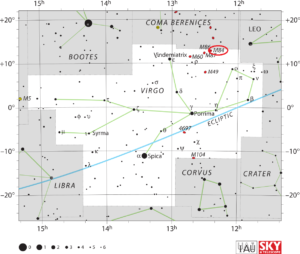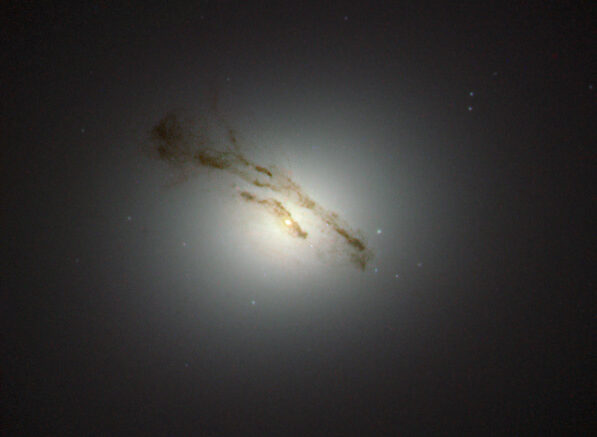| Description | |
| Visible From Pacific Northwest | December To May |
| Best Time To Observe | March and April |
| Minimum Size Of Viewing Device | Small Telescopes |
| Object Type | Elliptical or Lenticular Galaxy |
| Designations | Messier 84, M84, NGC 4374, PGC 40455, VCC 763, UGC 7494, ASB 33, 3C 272.1, 4C 13.47, DA 322, 2E 2696, 2E 1222.5+1309, GIN 778, IRAS 12224+1309, 2MASX J12250377+1253130, MCG+02-32-034, NRAO 399, MRC 1222+131, PKS J1225+1253, RX J1225.0+1253, Z 70-58, Z 1222.5+1310, VPC 385, |
| Right Ascension | 12h 25m 03.7s |
| Declination | +12°53’13’ |
| Constellation | Virgo |
| Number Of Stars | 400 Billion |
| Apparent magnitude | +10.1 |
| Apparent dimensions | 6′.5 x 5′.6 |
| Object Radius | 55,000 light years |
| Distance From Earth | 60 million light years |
History
Messier 84 is one of Charles Messier’s original discoveries. Messier discovered the object on March 18, 1781 and subsequently added it to his catalogue. On the same day, he also discovered and catalogued the globular cluster Messier 92, located in the constellation Hercules, and seven other galaxies in the Virgo Cluster: Messier 85, Messier 88 and Messier 91 in Coma Berenices, and Messier 86, Virgo A (M87), Messier 89 and Messier 90 in Virgo.
Describing M84, Messier noted, “Nebula without star, in Virgo; the center is a bit brilliant, surrounded with a slight nebulosity: its brightness & its appearance resemble that of those in this Catalogue, No.s 59 & 60. [Messier 59 and Messier 60]”
John Herschel catalogued M84 as h 1237 and later added it to the General Catalogue as GC 2930, describing it as “Very bright; pretty large; round; pretty suddenly brighter toward the middle; mottled.”
Locating M84 In The Sky
Messier 84 is located near the border with the constellation Coma Berenices. It can be found halfway along the line from Denebola in Leo to Vindemiatrix in Virgo. Another Messier object, M86, can be seen just 17 arc minutes to the east of M84. The two galaxies appear in the same field of view in binoculars and small telescopes.

Viewing M84
The galaxy is one of the brighter members of the Virgo Cluster, but not easily spotted in 10×50 binoculars. It can be seen with large binoculars and small telescopes, but requires clear, dark skies.
In small telescopes, the galaxies appear as small, oval-shaped patches of light with brighter centres. They are best seen in medium-sized and large telescopes. In 8-inch telescopes, several other galaxies can be seen in the vicinity, including NGC 4435, NGC 4388, NGC 4402 and NGC 4438. The giant elliptical galaxy M87 lies about 1.5 degrees to the southeast of M84 and M86. The best time of year to observe M84 and other galaxies in the Virgo Cluster is during the spring.
Photographing M84
If imaged properly, Messier 84 can be imaged in the same shot as M86 and M87 as part of Markarian’s Chain. Markarian’s Chain is a fantastic target for almost any type of instrument and camera. It is large enough to be photographed with small to medium size telescopes, and you can even capture it with just a DSLR camera and a telephoto lens! Bringing out the detail can be a bit challenging, but it is worth it. The best way to get guidance is to look at the link below or use astobin or cloudynights for a similar setup.
https://www.galactic-hunter.com/post/markarians-chain
Sources And Further Reading
Descriptions of all of Messier Objects can be found here.
https://www.nasa.gov/feature/goddard/2017/messier-84
https://freestarcharts.com/messier-84

Be the first to comment on "Messier 84"